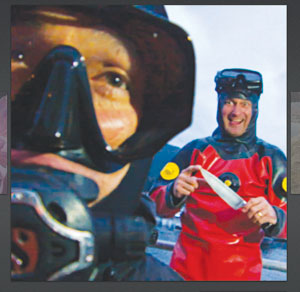

WHILE smartphone shutterbugs apply old-time filters to their photos, a Silicon Valley startup is exploring a whole new realm of picture taking. Mountain ViewÐbased Lytro, Inc., founded six years ago by Stanford University graduate Ren Ng, moves beyond emulsions, beyond pixels, andinto a new frontier known as light-field photography.
The just-released Lytro represents a completely different type of camera. Instead of capturing an image onto a sensor and interpreting it on a 2-D plane, Lytro’s technology records all the light rays in the scene using an array of microlenses.
With this technology, a wealth of visual data can be gathered and manipulated. Just as stereoscopic cameras take two slightly different images and put them together to create an illusion of depth, the Lytro assembles multiple perspectives that a user can choose from at will when fashioning a final image.
The magic comes with the processing software, which turns captured light rays into manipulatable images with variable depth of field—what Lytro calls “living pictures.’
Effectively, light-field photos can be altered on a computer after the fact and—as long as they’re in their original format—forever. According to the company, this will also lead to new software that will create 3-D images using the same data and “enable viewing on any 3-D display É to enable viewers to shift the perspective of the scene.’
The immediate plus, and the one most mentioned, is the ability to change the focus on an image after the fact. Objects at varying distances from the camera can be instantly popped in and out of focus. It is as if the Lytro came with a “no-regrets’ button.
One hurdle that the Lytro encounters is quantifying the picture quality, which might seem low by the accustomed standards of digital cameras. Lytro itself has had some trouble communicating this, since we’re living in a megapixel world, in which (for better or worse) a camera’s quality is judged on the MP number on the box.
In rebuttal, Lytro states that “to refer to megapixels when talking about light-field technology where there is no digital image is kind of like talking about what kind of film is used in a digital camera. Traditional camera terms are not translatable to this new type of picture.’
Relying on a new measurement system, the company says that the Lytro captures 11 megarays of light (translation: 11 million rays). Lytro notes that “when living pictures are shared, they are displayed on a variety of devices in HD quality.’
That’s a little vague, but the word on the street is that this camera won’t soon replace DSLRs or even point-and-shoot devices for resolution, but that the light-field photos are so unique Lytro is betting users won’t much care.
Another standard benchmark for a digital camera is low-light performance. Lytro has a fixed f/2 aperture (extremely wide to pull in as much light as possible). The company says that because its device uses all the light in a scene, the light-field camera is very responsive in low-light conditions “without use of a flash,’ although it notes that “a flash is possible and something we are looking into.’
Lytro is not the first company to explore the possibilities of the new technology. During the last decade, San Jose’s Adobe did research into their own flavor of light-field cameras. Using a combination of a freaky compound-lens attachment (it resembles a compound eye from some gigantic alien insect) and software, Adobe’s R&D team showed off the technology in 2008.
Although both projects accomplish the same thing, Lytro’s custom hardware and software are unrelated to Adobe’s research.
Lytro’s sensor is based on CMOS technology, uses an instant shutter (no rolling shutter issues like on mobile phone cameras) with no autofocus delay, the aforementioned f/2 fixed aperture, 6X optical zoom and a custom Light Field Engine computer to interpret the photos.
Lytro got started in 2006, but it was just last fall that word of a consumer camera got out. The hypersimple design—just a square tube with a lens-like opening at one end and a touchscreen at the other—is elegant in an Apple kind of way.
Even before you could actually buy one, the Lytro popped up on a number of 2011 holiday guides (including Metro‘s) as a must-have gift, or gift certificate. The camera even garnered Ng and company a nomination for an Edison award (the results will be announced April 26).
The first Lytro cameras just now shipping will start at $399 and be limited to Mac compatibility at first.
The major tech news outlets have started posting their reviews, and they’re mixed. The camera’s one-of-a-kind design and “living pictures’ are the major draw—the camera’s image quality, however, is not very high.
The Verge’s David Pierce wrote in his review: “If you’re curious about what’s next in photography, you should definitely buy the Lytro—if nothing else, it’s one of the best conversation starters I’ve encountered in a while, and the variable focus never fails to impress.’
Interestingly, the Lytro takes pictures in a square-format that looks decidedly retro compared to the landscape proportions of DSLR images—and echoes some of the formats available in apps like Instagram and Hipstamatic.
The format works just fine for swapping on the web, which is the primary goal. Lytro pics can be uploaded to the company’s website and moved to Facebook and other social-media sites. The best part is that on the web anybody can touch and refocus a Lytro image, adding a new layer of interactivity to photo sharing. And as Facebook is betting with Instagram, the future will be all about sharing. (Additional reporting by Michael S. Gant)


